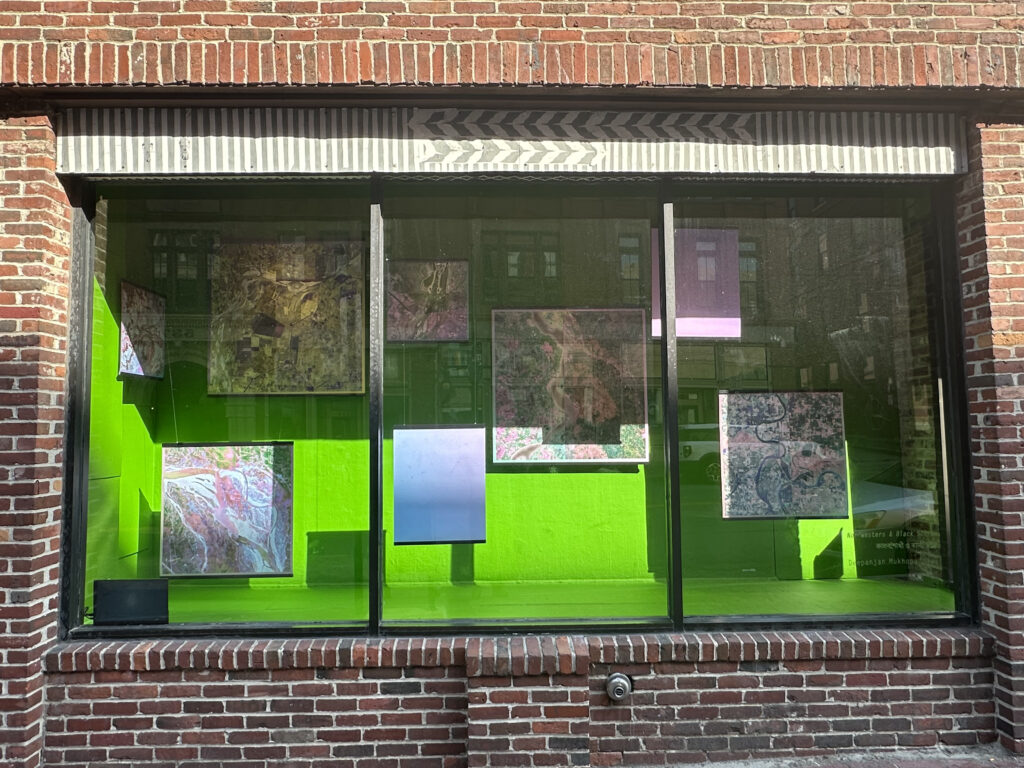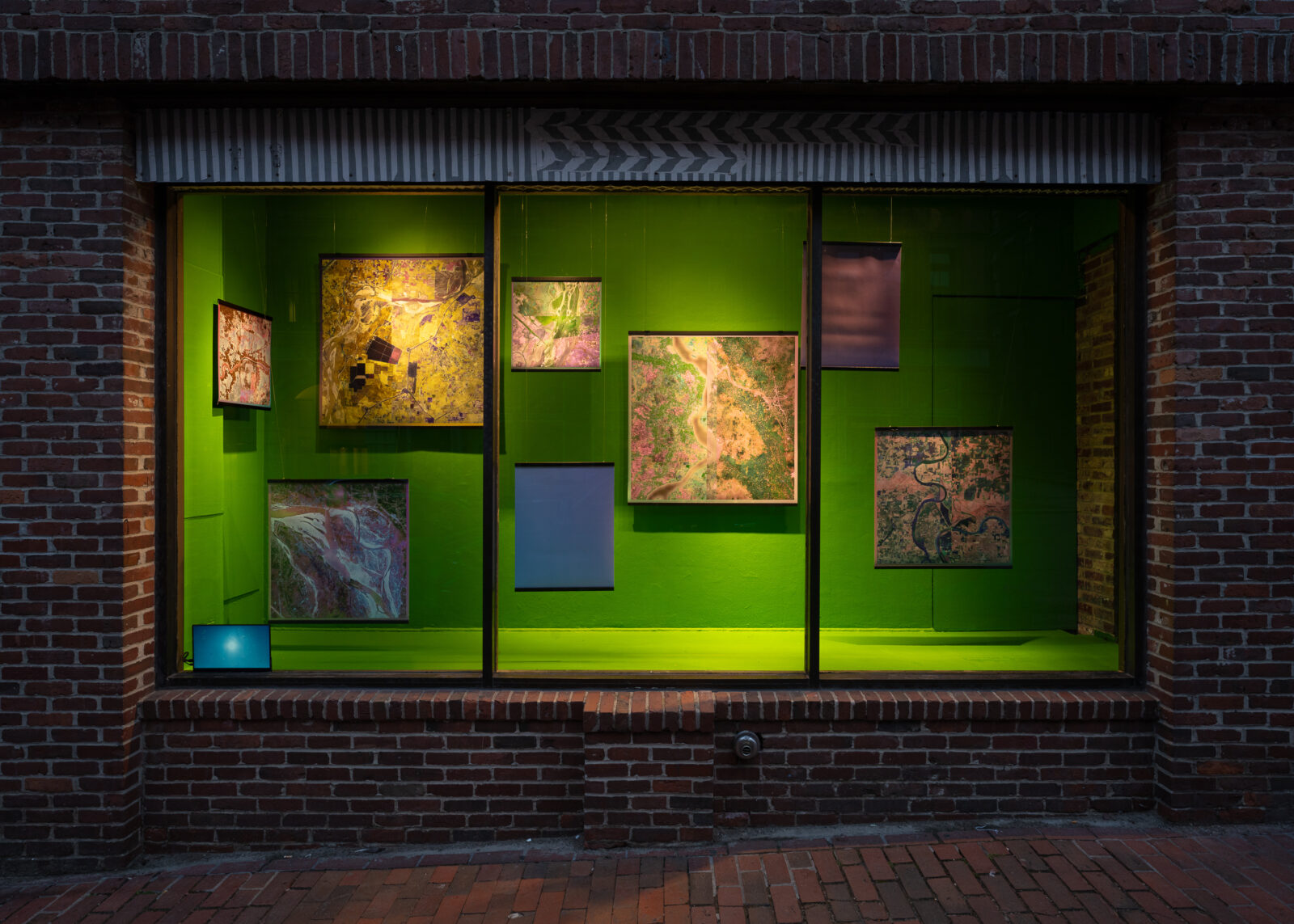Deepanjan Mukhopadhyay is an artist who looks to find and show truth in his work. Originally from Kolkata, India, “Deep” has a background in photography and currently works within various object- and image-based practices, investigating shifting meanings within post- and neocolonialism while reflecting on the very mediums of representation that he uses.
In this spirit, he created Nor’westers & Black Storms (কালবৈশাখী ও काली आँधी in Bengali and Hindi), an exhibition of satellite images of regions around the India-Bangladesh and India-Pakistan borders. The show is on view SPACE’s window gallery until August 9th.
At the center of the exhibition is the Radcliffe Line, the political divide that violently separated India from Pakistan and Bangladesh (formerly West Pakistan) and ended the British Raj. I got the chance to talk with the former Bowdoin College professor, who currently teaches at University of Memphis, about this project, as well as neocolonialism in art, AI, and his artistic process.
We met on July 4th, 2024, the day after his lecture at the Maine College of Art and Design.
The interview has been edited for clarity and length.
MF: Your artist statement has a pretty good background in the history necessary for understanding the context of your pieces. If you’re comfortable talking about it, I’m curious to know your personal connection to the Radcliffe Line and British Raj.
DM: From my understanding, no one in my family was directly affected by the Partition [of India in 1947], meaning my family members didn’t have to migrate. There might be a possibility that we’re a family that can trace its roots to a migrant from Bangladesh. There is trauma in the elder generations of my family, but not directly from Partition [but] Partition-related events, let’s say, because of the communal violence that happened during it.
MF: Could you go over the technical aspects of your project?
DM: I went on Google Maps and took screenshots of places near the Radcliffe Line. I was looking for regions that are around the border, as well as stitching glitches on the part of Google Maps.
I used hue shifting in Photoshop to exaggerate the colors. I have a theory why some of the colors are getting exaggerated, and that is because Google pulls data from different satellites. Not all of those satellites [are] for the primary purpose of satellite imagery for Google Maps. They might be there to study forests or oceans, so each might be slightly more sensitive to a certain hue (a specific wavelength) within the broader spectrum of the visible and invisible wavelength it is also sensitive to, and Google tempers wherever it was more sensitive to make it how our eyes might see it.
MF: Do you have anything to say about marrying history and art? Do you think that is something that you hold in your work, intentionally or unintentionally?
DM: I don’t know if it is always important to marry history and art. However, because of global and historical power dynamics, certain histories are not always told. From my understanding, history of the Partition was not widely taught in American schools, even though that was one of the largest mass migrations in history. I don’t know if I want to be the person who’s making this history available to everyone. For me, history is happening — I don’t know if history is always in the past. History affects us right now.
MF: What does this exhibition do for you in terms of conceptualizing migration and borders?
DM: I think less specifically about migration [than] about the land metaphorically. What does land mean to people? People in the subcontinent very much value land. They call it জমি (jami in Bengali; in Hindi, zameen or zamin), or the ground — that was theirs, that meant a lot to people. Political map-making is imposing scars on that landscape. Maybe what I’m trying to do is metaphorically think of the Bengali and the Punjabi community dealing with this migration by looking at the land, because the land is changing. The land is sometimes not following the borders.
MF: I think there’s definitely a feeling or an effect there. The Radcliffe Line was [drawn] by someone who had never even been to India [and] in a month just did this and left. That doesn’t necessarily change the physical landscape.
DM: I don’t even know if actual borders were enforced and set up during the migration. People were like, we think this is going to be part of India. We’ve traveled far enough.
MF: You talked yesterday in the lecture [at MECA&D] about your departure from traditional or documentary photography. You mentioned not feeling satisfied with the idea that you create a body of work and then have X amount of prints in the same size, on a gallery wall, one after the other. What does the form feel like for you in this project?
DM: I don’t go out there saying I’m gonna make work that’s non-traditional or I’m gonna make work that’s traditional. What I really enjoy is (makes gestures to map prints) I want to put this beside this. And I want to put that beside this video. I pay attention to scale and the physicality of the printed object. Even in Appropriated Figure Grounds, which are framed prints on the wall, they end up looking object-like, because [of] the way they get installed. Maybe they veer out into not just being prints, but being a little bit object-like — holding space, interacting with each other in the space.
MF: Another topic I am interested in getting into is AI. For me, it feels a little scary sometimes. But you mentioned in the lecture last night that you don’t actually have that many pieces that involve AI?
DM: That’s correct.
MF: You have the Deepfake Derrida piece. You’ve taught digital media. Is there anything you want to share about AI that you find most interesting or scary or concerning or beautiful?
DM: I have a lot of thoughts about AI. I follow it more from a cultural studies point of view. I’m interested in language, and when these large language models came out, people were immediately like, are these conscious? What is consciousness? Are they really thinking, or are they predicting the next token? Are humans always just predicting the next token? Was that Derrida’s way of thinking about language?
There are people that I follow closely who say AI isn’t conscious. People like [sci-fi author] Ted Chiang or Noam Chomsky. At the moment, they are like, no, it’s just a next token prediction machine, they don’t have consciousness yet. I’m really interested in that, in how people behave with AI. With a lot of large language models — if you tell them things nicely, if you tell them that you will reward them, they will do a better job.

MF: Really?
MF: And I wonder, is that because AI structures know that’s a way that humans behave?
DM: It might be that’s what it’s figured out from reading all the human language. [Sometimes] it sees that when [people are offered] a prize, the answers have been better.
There are a few other things about AI that I think about. One is, of course, its impact on labor and job loss and on artists. I am concerned about that, but that’s a capitalism problem, a regulation problem, not necessarily an AI problem. There are always going to be technological advancements and automations. The way to tackle that is through regulation.
AI is good at what I call illustration. Illustration is one of the things that art can do, but art can do so much more. The kind of art that AI makes is essentially illustrating language — you tell it something, and it illustrates that for you. Even if you say, AI can make abstractions, it’s only making abstractions because you’re telling it to make abstractions. It’s illustrating abstraction.
MF: If AI is something that’s threatening to people, maybe thinking of it from that perspective can kind of tear it down a little bit.
DM: Yeah. I get a lot of questions, especially from non-artists regarding art and AI. And I’m like, how can you make art without having a body? You need to have a body to have certain cognitive sensations. So far, AI maybe only has the visual part. It cannot feel pain. Now, I also think you can make an AI that can have a body, a theoretical body. It doesn’t have to be a humanoid-like body. You can train it on sensory data, you can give it a hypothetical body, and maybe it can become better at making art.
People are now navigating more towards doing things by their hands, more interested in the process than the result. Because of AI, people are like, no, I’m not actually going to generate through AI. I’m going to paint. Most of my students dislike AI. In terms of the negative aspects of AI, I am scared as well. I’m scared because AI is coming up in a capitalist system — not necessarily directly scared of AI, because I think AI has the potential to make some breakthroughs that can save us from climate change.
AI has helped some very important scientific problems, such as in the field of protein folding, and has the potential to make major breakthroughs that can help humanity.
MF: I’m also wondering about your project “Decolonial Figurations.” There’s been lots of discourse about monuments and statues in the U.S. Was that something that you thought about while making the project?
DM: I have thought about multiple large 3D prints, and have them as public sculptures near the original. We would do it in both locations. Let’s say one of the pieces uses the public sculpture at Trafalgar square and then also uses [an] artifact that’s currently in Copenhagen, Denmark. If I can show the work [in both locations] and at the same time — I hate saying “to initiate a conversation” — but I think that would give [the piece] good context.
MF: Why do you hate saying to initiate a conversation?
DM: I mean, since 2020 — it’s now 2024 — and there have been few systemic changes. That’s how I feel. As a person of color, we have been having those discussions way before George Floyd. To be honest, we don’t need to initiate these discussions, because most of the people operating at these institutions are educated aware of problematic provenances. But one thing that could help — I always think about the viewer and ask, what does the viewer take away from it? Maybe it’ll be on their mind.
Deepanjan Mukhopadhyay’s Nor’westers and Black Storms is in the SPACE Gallery window through August 9.

